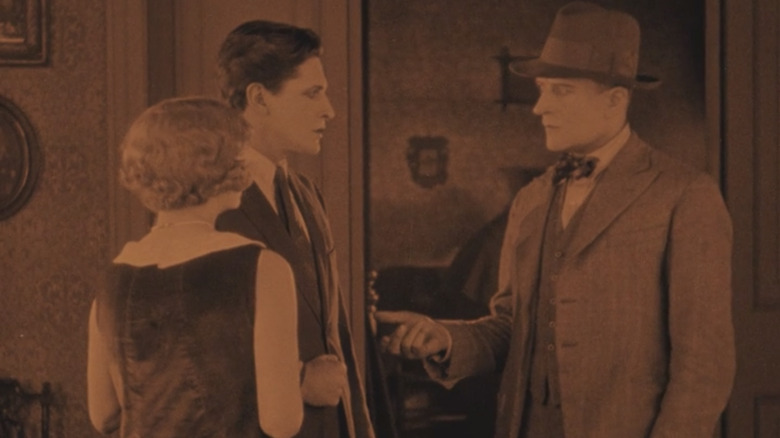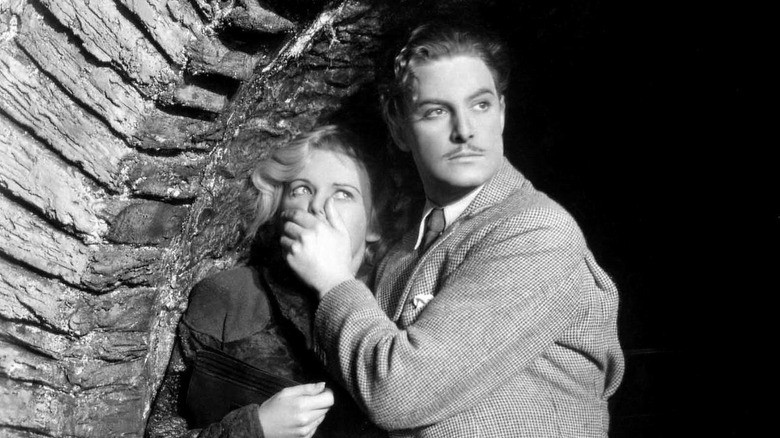There's A Very Hitchcock Explanation For Alfred Hitchcock's Handcuff Obsession
If you're a fan of Alfred Hitchcock, you may have noticed a certain item heavily featured in his work: handcuffs. The filmmaker uses them for their symbolic poignancy and as a means of visual storytelling. They are an excellent device for the aesthetically refined delivery of important narrative information. They contribute to a scene's suspense and feelings of entrapment and sometimes have the added bonus of sexual suggestion. As a motif, handcuffs encapsulate many of the elements that are central to Hitchcock's work.
Handcuffs are featured prominently in some of Hitch's earliest films, like the 1927 thriller "The Lodger" (seen above). In the film, a married couple is suspicious that their new tenant might be behind a recent string of murders, but their precocious daughter is charmed by his looks. Her boyfriend, a detective, grows incredibly suspicious of the lodger before finally arresting him. Once arrested, the lodger escapes, still in handcuffs.
"The finale of The Lodger, when the hero is handcuffed, suggests a lynching," the acclaimed French New Wave filmmaker Francois Truffaut said, hitting the nail right on the head as usual (via Hitchcock/Truffaut). The handcuffs on the hero's arms resemble a noose around a hanged man's neck. He is paraded down the stairs and out the door just as a lynched man is escorted to the gallows.
In the climactic scene before the epilogue, the poor lodger is stuck hanging from a fence, caught by his handcuffs, as he is harassed by an angry mob. His arrest becomes a spectator sport in a way that is reminiscent of a public lynching. Truffaut also suggested that the scene called the crucifixion to mind. "Naturally, that thought did occur," the Master of Suspense confirmed.
'It's somewhere in the area of fetishism, isn't it?'
"The Lodger" is one of the first truly "Hitchcockian" films, Truffaut says, because it establishes some of the themes and motifs that would define his work. One such theme is the spectacle of crime and images of people being arrested captured this phenomenon. "Look at the way the newspapers like to show people being taken to jail in handcuffs," he offered. Another distinctly Hitchcockian theme that "The Lodger" establishes is the accusation of innocent men. "The theme of the innocent man being accused, I feel, provides the audience with a great sense of danger," Hitch explained. "It's easier for them to identify with him than with a guilty man on the run. I always take the audience into account." This motif appears again in "North by Northwest." But there's another intention behind Hitchcock's use of handcuffs.
An innocent man in handcuffs can also be found in Hitchcock's 1935 mystery "The 39 Steps." The protagonist gets mixed up with a spy ring and one of their agents is killed at his apartment, which makes him look suspicious. The detectives on his trail finally arrest him and handcuff him to a woman who reluctantly agrees to identify him. The couple being handcuffed together had a "sexual connotation," Hitchcock said. He was fascinated by the long history of "sexual aberration through restraint."
Hitchcock takes an even more twisted interest in handcuffs than Truffaut observes in other films.. "Psychologically, of course, the idea of the handcuffs has deeper implications," he told the French filmmaker. "Being tied to something... it's somewhere in the area of fetishism, isn't it?" Who knew the old man was so kinky? Everyone knew this. Everyone.
Hitch certainly knew how to channel the perverse into his work. Recurring images like handcuffs presented layered meaning to his audiences that could be peeled back at their leisure. Accessible yet dimensional motifs like this one are exactly what makes his work worth studying to this day.

